Shubham Jain
StatsMerging: Statistics-Guided Model Merging via Task-Specific Teacher Distillation
Jun 05, 2025Abstract:Model merging has emerged as a promising solution to accommodate multiple large models within constrained memory budgets. We present StatsMerging, a novel lightweight learning-based model merging method guided by weight distribution statistics without requiring ground truth labels or test samples. StatsMerging offers three key advantages: (1) It uniquely leverages singular values from singular value decomposition (SVD) to capture task-specific weight distributions, serving as a proxy for task importance to guide task coefficient prediction; (2) It employs a lightweight learner StatsMergeLearner to model the weight distributions of task-specific pre-trained models, improving generalization and enhancing adaptation to unseen samples; (3) It introduces Task-Specific Teacher Distillation for merging vision models with heterogeneous architectures, a merging learning paradigm that avoids costly ground-truth labels by task-specific teacher distillation. Notably, we present two types of knowledge distillation, (a) distilling knowledge from task-specific models to StatsMergeLearner; and (b) distilling knowledge from models with heterogeneous architectures prior to merging. Extensive experiments across eight tasks demonstrate the effectiveness of StatsMerging. Our results show that StatsMerging outperforms state-of-the-art techniques in terms of overall accuracy, generalization to unseen tasks, and robustness to image quality variations.
Memory Proxy Maps for Visual Navigation
Nov 15, 2024



Abstract:Visual navigation takes inspiration from humans, who navigate in previously unseen environments using vision without detailed environment maps. Inspired by this, we introduce a novel no-RL, no-graph, no-odometry approach to visual navigation using feudal learning to build a three tiered agent. Key to our approach is a memory proxy map (MPM), an intermediate representation of the environment learned in a self-supervised manner by the high-level manager agent that serves as a simplified memory, approximating what the agent has seen. We demonstrate that recording observations in this learned latent space is an effective and efficient memory proxy that can remove the need for graphs and odometry in visual navigation tasks. For the mid-level manager agent, we develop a waypoint network (WayNet) that outputs intermediate subgoals, or waypoints, imitating human waypoint selection during local navigation. For the low-level worker agent, we learn a classifier over a discrete action space that avoids local obstacles and moves the agent towards the WayNet waypoint. The resulting feudal navigation network offers a novel approach with no RL, no graph, no odometry, and no metric map; all while achieving SOTA results on the image goal navigation task.
Few-Class Arena: A Benchmark for Efficient Selection of Vision Models and Dataset Difficulty Measurement
Nov 02, 2024



Abstract:We propose Few-Class Arena (FCA), as a unified benchmark with focus on testing efficient image classification models for few classes. A wide variety of benchmark datasets with many classes (80-1000) have been created to assist Computer Vision architectural evolution. An increasing number of vision models are evaluated with these many-class datasets. However, real-world applications often involve substantially fewer classes of interest (2-10). This gap between many and few classes makes it difficult to predict performance of the few-class applications using models trained on the available many-class datasets. To date, little has been offered to evaluate models in this Few-Class Regime. We conduct a systematic evaluation of the ResNet family trained on ImageNet subsets from 2 to 1000 classes, and test a wide spectrum of Convolutional Neural Networks and Transformer architectures over ten datasets by using our newly proposed FCA tool. Furthermore, to aid an up-front assessment of dataset difficulty and a more efficient selection of models, we incorporate a difficulty measure as a function of class similarity. FCA offers a new tool for efficient machine learning in the Few-Class Regime, with goals ranging from a new efficient class similarity proposal, to lightweight model architecture design, to a new scaling law. FCA is user-friendly and can be easily extended to new models and datasets, facilitating future research work. Our benchmark is available at https://github.com/fewclassarena/fca.
Representation Similarity: A Better Guidance of DNN Layer Sharing for Edge Computing without Training
Oct 15, 2024Abstract:Edge computing has emerged as an alternative to reduce transmission and processing delay and preserve privacy of the video streams. However, the ever-increasing complexity of Deep Neural Networks (DNNs) used in video-based applications (e.g. object detection) exerts pressure on memory-constrained edge devices. Model merging is proposed to reduce the DNNs' memory footprint by keeping only one copy of merged layers' weights in memory. In existing model merging techniques, (i) only architecturally identical layers can be shared; (ii) requires computationally expensive retraining in the cloud; (iii) assumes the availability of ground truth for retraining. The re-evaluation of a merged model's performance, however, requires a validation dataset with ground truth, typically runs at the cloud. Common metrics to guide the selection of shared layers include the size or computational cost of shared layers or representation size. We propose a new model merging scheme by sharing representations (i.e., outputs of layers) at the edge, guided by representation similarity S. We show that S is extremely highly correlated with merged model's accuracy with Pearson Correlation Coefficient |r| > 0.94 than other metrics, demonstrating that representation similarity can serve as a strong validation accuracy indicator without ground truth. We present our preliminary results of the newly proposed model merging scheme with identified challenges, demonstrating a promising research future direction.
Preserving Individuality while Following the Crowd: Understanding the Role of User Taste and Crowd Wisdom in Online Product Rating Prediction
Sep 06, 2024



Abstract:Numerous algorithms have been developed for online product rating prediction, but the specific influence of user and product information in determining the final prediction score remains largely unexplored. Existing research often relies on narrowly defined data settings, which overlooks real-world challenges such as the cold-start problem, cross-category information utilization, and scalability and deployment issues. To delve deeper into these aspects, and particularly to uncover the roles of individual user taste and collective wisdom, we propose a unique and practical approach that emphasizes historical ratings at both the user and product levels, encapsulated using a continuously updated dynamic tree representation. This representation effectively captures the temporal dynamics of users and products, leverages user information across product categories, and provides a natural solution to the cold-start problem. Furthermore, we have developed an efficient data processing strategy that makes this approach highly scalable and easily deployable. Comprehensive experiments in real industry settings demonstrate the effectiveness of our approach. Notably, our findings reveal that individual taste dominates over collective wisdom in online product rating prediction, a perspective that contrasts with the commonly observed wisdom of the crowd phenomenon in other domains. This dominance of individual user taste is consistent across various model types, including the boosting tree model, recurrent neural network (RNN), and transformer-based architectures. This observation holds true across the overall population, within individual product categories, and in cold-start scenarios. Our findings underscore the significance of individual user tastes in the context of online product rating prediction and the robustness of our approach across different model architectures.
Inherent Challenges of Post-Hoc Membership Inference for Large Language Models
Jun 25, 2024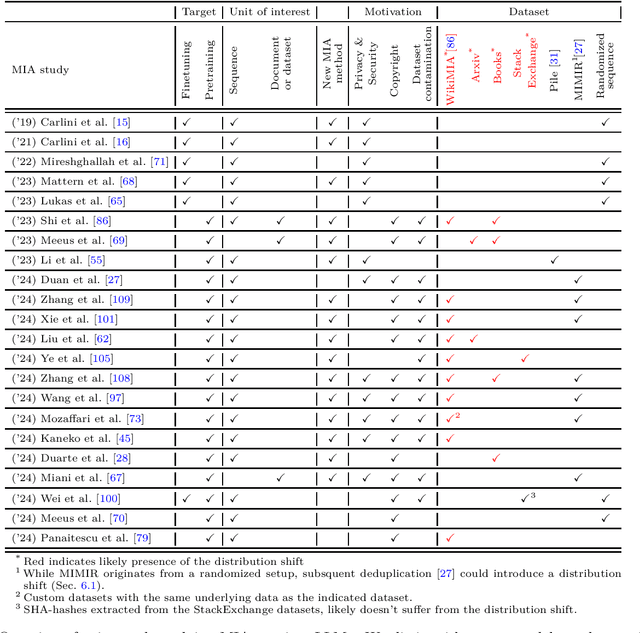
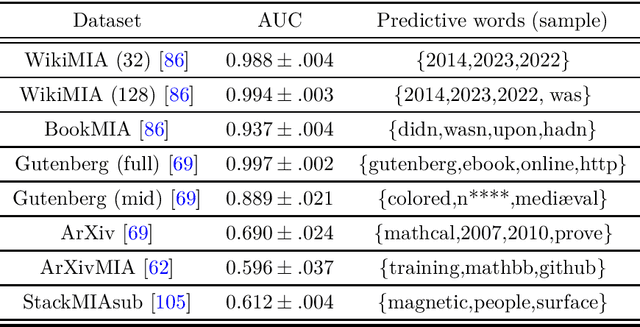
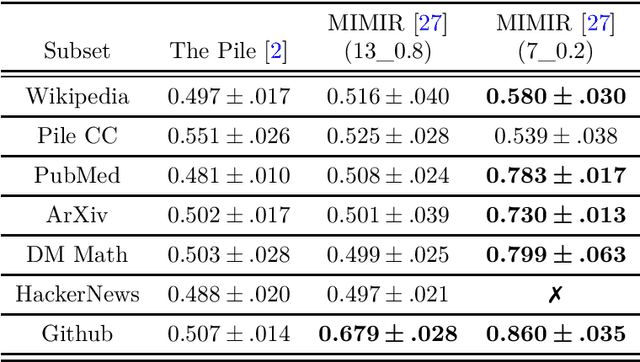
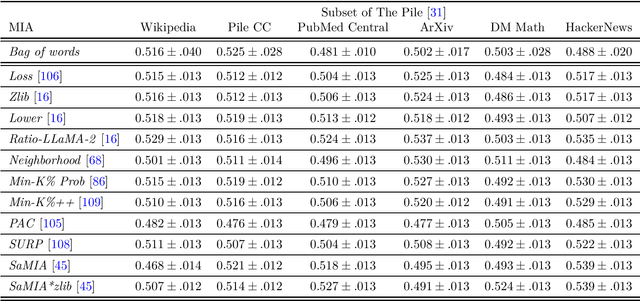
Abstract:Large Language Models (LLMs) are often trained on vast amounts of undisclosed data, motivating the development of post-hoc Membership Inference Attacks (MIAs) to gain insight into their training data composition. However, in this paper, we identify inherent challenges in post-hoc MIA evaluation due to potential distribution shifts between collected member and non-member datasets. Using a simple bag-of-words classifier, we demonstrate that datasets used in recent post-hoc MIAs suffer from significant distribution shifts, in some cases achieving near-perfect distinction between members and non-members. This implies that previously reported high MIA performance may be largely attributable to these shifts rather than model memorization. We confirm that randomized, controlled setups eliminate such shifts and thus enable the development and fair evaluation of new MIAs. However, we note that such randomized setups are rarely available for the latest LLMs, making post-hoc data collection still required to infer membership for real-world LLMs. As a potential solution, we propose a Regression Discontinuity Design (RDD) approach for post-hoc data collection, which substantially mitigates distribution shifts. Evaluating various MIA methods on this RDD setup yields performance barely above random guessing, in stark contrast to previously reported results. Overall, our findings highlight the challenges in accurately measuring LLM memorization and the need for careful experimental design in (post-hoc) membership inference tasks.
A Lightweight Measure of Classification Difficulty from Application Dataset Characteristics
Apr 09, 2024



Abstract:Despite accuracy and computation benchmarks being widely available to help choose among neural network models, these are usually trained on datasets with many classes, and do not give a precise idea of performance for applications of few (< 10) classes. The conventional procedure to predict performance is to train and test repeatedly on the different models and dataset variations of interest. However, this is computationally expensive. We propose an efficient classification difficulty measure that is calculated from the number of classes and intra- and inter-class similarity metrics of the dataset. After a single stage of training and testing per model family, relative performance for different datasets and models of the same family can be predicted by comparing difficulty measures - without further training and testing. We show how this measure can help a practitioner select a computationally efficient model for a small dataset 6 to 29x faster than through repeated training and testing. We give an example of use of the measure for an industrial application in which options are identified to select a model 42% smaller than the baseline YOLOv5-nano model, and if class merging from 3 to 2 classes meets requirements, 85% smaller.
A Landmark-Aware Visual Navigation Dataset
Feb 22, 2024



Abstract:Map representation learned by expert demonstrations has shown promising research value. However, recent advancements in the visual navigation field face challenges due to the lack of human datasets in the real world for efficient supervised representation learning of the environments. We present a Landmark-Aware Visual Navigation (LAVN) dataset to allow for supervised learning of human-centric exploration policies and map building. We collect RGB observation and human point-click pairs as a human annotator explores virtual and real-world environments with the goal of full coverage exploration of the space. The human annotators also provide distinct landmark examples along each trajectory, which we intuit will simplify the task of map or graph building and localization. These human point-clicks serve as direct supervision for waypoint prediction when learning to explore in environments. Our dataset covers a wide spectrum of scenes, including rooms in indoor environments, as well as walkways outdoors. Dataset is available at DOI: 10.5281/zenodo.10608067.
Feudal Networks for Visual Navigation
Feb 19, 2024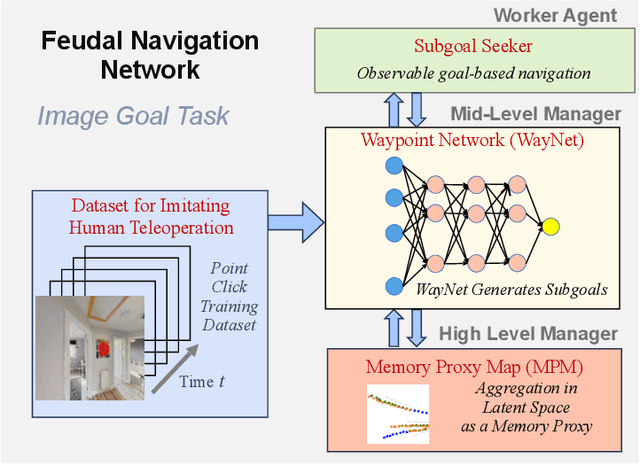

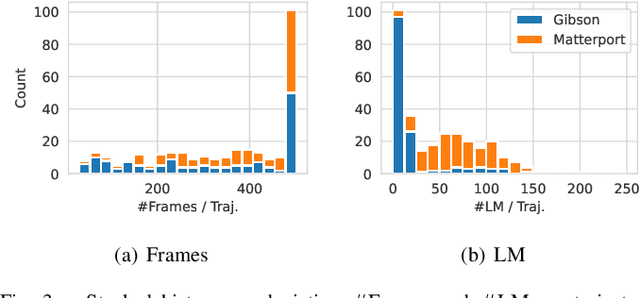
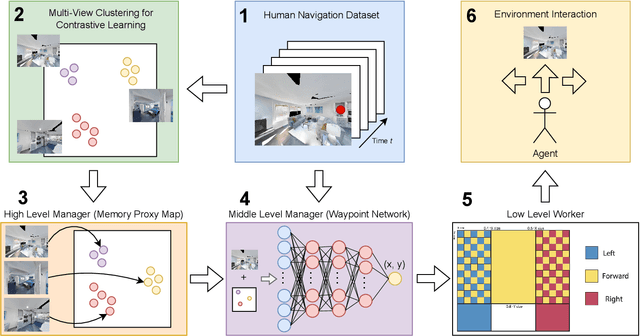
Abstract:Visual navigation follows the intuition that humans can navigate without detailed maps. A common approach is interactive exploration while building a topological graph with images at nodes that can be used for planning. Recent variations learn from passive videos and can navigate using complex social and semantic cues. However, a significant number of training videos are needed, large graphs are utilized, and scenes are not unseen since odometry is utilized. We introduce a new approach to visual navigation using feudal learning, which employs a hierarchical structure consisting of a worker agent, a mid-level manager, and a high-level manager. Key to the feudal learning paradigm, agents at each level see a different aspect of the task and operate at different spatial and temporal scales. Two unique modules are developed in this framework. For the high-level manager, we learn a memory proxy map in a self supervised manner to record prior observations in a learned latent space and avoid the use of graphs and odometry. For the mid-level manager, we develop a waypoint network that outputs intermediate subgoals imitating human waypoint selection during local navigation. This waypoint network is pre-trained using a new, small set of teleoperation videos that we make publicly available, with training environments different from testing environments. The resulting feudal navigation network achieves near SOTA performance, while providing a novel no-RL, no-graph, no-odometry, no-metric map approach to the image goal navigation task.
Has Your Pretrained Model Improved? A Multi-head Posterior Based Approach
Jan 15, 2024



Abstract:The emergence of pretrained models has significantly impacted Natural Language Processing (NLP) and Computer Vision to relational datasets. Traditionally, these models are assessed through fine-tuned downstream tasks. However, this raises the question of how to evaluate these models more efficiently and more effectively. In this study, we explore a novel approach where we leverage the meta features associated with each entity as a source of worldly knowledge and employ entity representations from the models. We propose using the consistency between these representations and the meta features as a metric for evaluating pretrained models. Our method's effectiveness is demonstrated across various domains, including models with relational datasets, large language models and image models.
 Add to Chrome
Add to Chrome Add to Firefox
Add to Firefox Add to Edge
Add to Edge